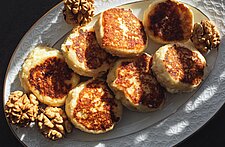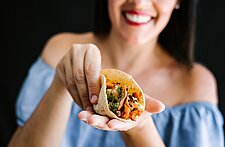 By Emmanuel Laroche, VP Marketing & Consumer Insights, Symrise NA
By Emmanuel Laroche, VP Marketing & Consumer Insights, Symrise NA
“You are French… and living in the US?!?!... I have never met French people living in the US before!” said a man to my children and I while walking in Centro Vedado, Havana. It was our first night out and we were trying to find our way back to our apartment. “Dad! A guy has been following us for a while,” whispered my son in the dark Calle 25th of the Centro Vedado district. The owner of our Airbnb assured us that walking, even late in the streets of Vedado, was totally safe, so I was not particularly concerned. Intrigued by our French and English conversation, our new walking buddy decided to interact with us and was happy to recommend places in the neighborhood to listen for local music. “Casa de la Musica is a must, as well as the Jazz Club La Zorra y El Cuervo.” He greeted us with “Have a great night!” while disappearing in a dark side street.
Going to Cuba has been on my bucket list for a long time and was atop my travel wish list for 2016. I wanted to experience Havana now, before the lifting of the travel ban resulted in some well-known American brands occupying every street corner in the Cuban capital.
CLICK HERE to view The One Reason You Need to go to Panama
After our visitor had left us, my children and I looked at each other and realized we had experienced the first genuine moment of our trip; it was exciting, it was natural and it was the start of something special. And it wasn’t a fleeting experience, since our trip to Havana was rich in interactions with some truly amazing people.

William, our private taxi driver, was proudly wearing a white Panama hat while driving his recently refurbished bright orange 1950 Buick convertible. The car, which was parked between the Habana Gran Teatro and the Inglaterra Hotel at the entrance of the Paseo de Marti, seemed to be part of a Havana advertisement from the 50s! Like a many of Cuba’s baby boomers, William inherited his car from his father. Everywhere in Havana, our path crossed thousands of bright colored American cars from the 50s – a blue 1954 Plymouth, a red ’53 Buick, a pink Chevrolet Deluxe from 1952, a classic ’56 Merc Montclair in purple, and even a green Ford Model A from 1929. A well-known visual identity of Havana, they can’t be missed. The best location to admire a convoy of them is along Malecon and at the Plaza de la Revolucion.
CLICK HERE to subscribe to our weekly newsletter!
I told William that I had seen the beautiful Parque Metropoitano on the outskirts of Miramar in the Netflix series “Four Season in Havana” a couple of weeks before our trip. William immediately felt compelled to show us the beauty of the area in person. “Four Seasons in Havana” has been characterized as Caribbean Noir. The police drama accurately depicts the sensuality of Cubans, the sensorial elements of the music they listen to and their attitude towards eating. The park is a propagated urban jungle on the banks of the Río Almendares and makes for a stunning landscape to discover on a late afternoon hike.
Cuban Food and Drinks
On the Paseo de Marti, we visited the restaurant La Terraza, which is located on the third floor of the Asociation Asturiana building. La Terraza is known for the grill they have on an open deck that features a beautiful view of the Prado. “Octopus is the new pork belly,” mentioned Antoinette Bruno at the last StarChefs ICC in Brooklyn. Octopus /(Pulpo) is on every menu in Havana and the grilled octopus at La Terrazza is among the best I’ve ever had.

One reason it moved quickly up my list of favorites is because it was paired with a customized Gin & Tonic! They feature a great concept where you select your favorite brand of gin, your profile of tonic and your shape of glass, and the bartender tops it off by offering you a selection of add-ins including herbs like parsley, Herba Buena, basil or rosemary and spices such as pink pepper, licorice, cardamom, cinnamon or rose petals and hibiscus flowers. Simply delicious!

A server at La Terraza named Joe opened the wood and glass doors from El Salon de Fumadores, leading us into a dark room of leather sofas, cigar boxes and an assortment of old rum bottles. No one else was in this little comfy paradise, only two levels up from one of the busiest boulevard in Havana. Two hours of tasting, open discussion and cigar smoking! I am not really a cigar aficionado but many years ago in France, I was introduced to cigar smoking by a former boss, Roberto Rosellini. My children and I went for a Monte Cristo #3 and Joe offered us a glass of Santiago de Cuba Anejo. Joe shared with us that he has a sister who lives in Paris, but he has not seen her in many years and it is impossible for him at the moment to travel to France. Joe is a young Cuban with the same hopes and values as his millennial counterparts in the US, wondering what the future of his country will be.

Cuba is imprinted upon me. I cannot get the colorful names of the five main Havana districts out of my head: Miramar, Vedado, Centro Habana and Habana Vieja. For many visitors, the crumbling buildings and bustling streets of Centro Habana, crammed between the hotel districts of Habana Vieja and Vedado, are glimpsed only through a taxi window en route to the city’s more tourist-friendly areas. Yet in this no-thrills quarter where more than 150,000 people live, there is the emblem of Havana La Guarida Paladar. For visitors to Havana, La Guarida has become a must-see experience. We met with Enrique, one of the owners of this magical place. He has created a cozy atmosphere with soft lights, fine table linen, candles and Cuban jazz music. The entrance is off a run-down street, which magnifies the effect. You can see the former grandeur of this building with a gigantic wooden door, which opens on two flights of marble stairs. The second level offers a photographer’s dream: a scene of drying sheets in the dilapidated architecture of the Paladar. Fidel’s famous expression of “Patria o Muerte” (country or death) is another iconic picture on the way down. Try the lasagna de papaya, the gazpacho and the suckling pig with its orange honey reduction and finish your meal with their special coffee drink!
http://www.laguarida.com/en/

Cuba seems to be on the mind of more people than myself. Recently, it feels like everyone I have spoken with since my trip is planning to visit Cuba in 2017! I am really pleased that I was able to witness a Havana which in ten years’ time might no longer exist. La calle Opbispo with its tourists, and La Floridita bar and the Daiquiris made famous by Hemingway…La calle Empedrado with La Bodeguita Del Medio, famous for its Mojitos and Cuban musicians who play there...the restaurant Doña Eutimia, just off La Plaza de la Catedral, with a portrait of the founder still residing above the entranceway. You must not miss their amazing garlic octopus and the most delicious frozen greenish mojitos.

If you are planning to go to Havana, I suggest you connect with “El Duke” at the restaurant Mediterraneo Havana on calle 13 near Aenida de los Presidentes, close to the Hotel Presidente. This young, welcoming manager is a great source of information. The hotel is located in a typical Vedado mansion and its second-floor balcony offers a wonderful outdoor atmosphere. “El Duke” will explain to you that Mediterraneo is the only “'de la granja a la mesa'” / “farm to table” restaurant in Cuba today, featuring ingredients from farms located in the rural area of Guanabacoa.
All the tagliatelle pasta dishes are homemade and the octopus Genovese style (pesto) is divine.
http://www.medhavana.com/index.php/en/
Cuban Coffee
Coffee came to Cuba in the mid-1700s, and soon thereafter Cuba became a large coffee producer and exporter. As coffee production grew, the drink became part of the national identity. All Cubans have access to coffee, as they receive a monthly coffee ration, although this ration is cut with ground chicharo beans. The coffee is prepared in a stovetop espresso maker. Every home has one. I was asking everywhere about café Cubano but what everyone outside of Cuba calls a café Cubano is, in fact, the traditional Cuban espresso, and it is an integral part of local culture. Cubans are very serious about their coffee. Every morning, our friend Felix, ex-manager of the Cuban cigar factories and now taxi driver and owner of our Airbnb, was pleased to offer me a small cup of his homemade sweet and dark coffee. I knew it was time for conversation with my broken-Spanish. I know it is highly unlikely that Felix will ever read this post, but I know that do I miss your warmth and generosity.

For a great cup of sweet Cuban espresso take a seat at the Café El Escorial’s terrace on Plaza Vieja in Habana Vieja. The coffee is excellent, everything from Cuban coffee, café au lait, coffee frappé, coffee liquor through to coffee daiquiri.
For this Franco-American, Cuba was everything I could have hoped for, and more. As a person who loves food, drink and travel, Havana is a sensory delight. If it’s not on your own bucket list, it should be.
CLICK HERE to view all of our Latin flavor, food and beverage insights on in-sight!





